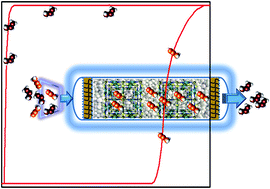A robust heterometallic ultramicroporous MOF with ultrahigh selectivity for propyne/propylene separation†
Abstract
Highly efficient removal of trace propyne (C3H4) (propyne <1000 ppm) from propylene (C3H6) is an essential and challenging industrial process due to the high molecular similarity of C3H4 and C3H6. Herein, we created a new ultramicroporous metal–organic framework (NKMOF-11) with exceptional water stability, superior C3H4 binding affinity, and ultrahigh uptake capacity of C3H4 at ultra-low pressure (0.1 mbar). Modelling studies revealed that the excellent performance of NKMOF-11 can be attributed to the suitable pore aperture and unique binding sites for C3H4 through strong hydrogen bonding and π–π interactions. Attributed to the preferred adsorption of C3H4, NKMOF-11 possessed ultrahigh selectivities towards C3H4/C3H6 mixtures (1/99 and 1/999 (v/v)) at room temperature. The simulation and experimental breakthrough results further revealed that NKMOF-11 possesses excellent separation performance towards C3H4 and C3H6 binary mixtures (1/99 and 1/999) and sets a new record for the productivity of polymer-grade C3H6 (>99.996%) among all reported materials. This study paves a new avenue for the design of adsorbent materials with both high selectivity and high productivity for a C3H4/C3H6 binary mixture.



 Please wait while we load your content...
Please wait while we load your content...